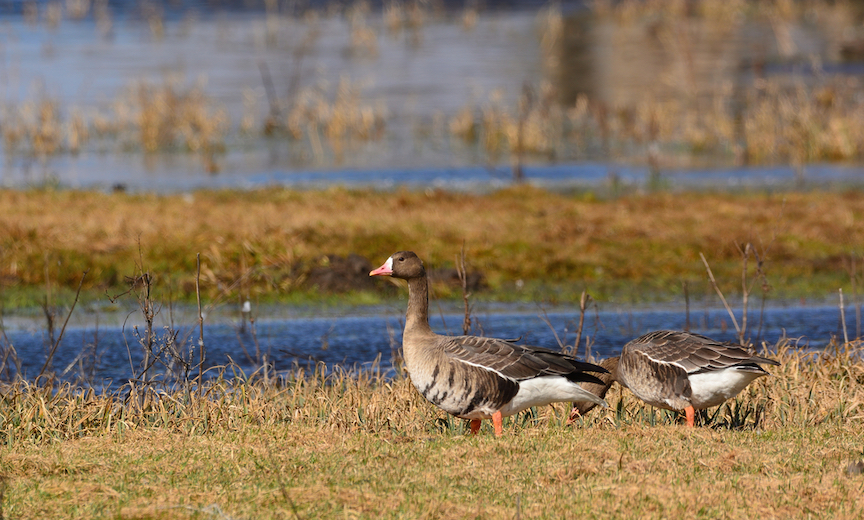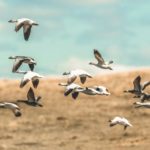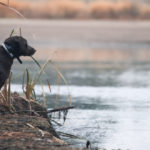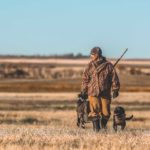Species Profile and Hunting Tips for Targeting Specklebellies
The greater white-fronted goose (Anser albifrons) is a small brown goose named for the white feathers surrounding its bill. Because of the dappled black markings on its creamy light breast (kind of resembling a birch or aspen tree), it is often called the “specklebelly” by waterfowl hunters.
Description and Life History of the White-Fronted Goose
Greater white-fronted geese are usually about 27 to 29 inches in length and weigh about 5 to 6 pounds (Ducks Unlimited 2020). Its cousin, the lesser white-fronted goose (A. erythropus) is smaller and occurs primarily in Europe and Asia. The goose’s sides, neck, and head are brown, and its back and tail end are darker brown than the rest of it (All About Birds 2020). Its breast is creamy brown, with black or dark brown bars, as mentioned above. Its belly, under-tail, and around its bill are white. Specklebellies have orange legs and a pinkish/orange bill. While flying, their wings are gray colored and they have a white U-shape on their rear above their darker tails. Males and females look basically the same, apart from the males being slightly larger.
These small geese often spend their winters with flocks of snow geese and sometimes Canada geese. But during the breeding season, they tend to nest alone or in very loose colonies. White-fronted geese mate for life, and nesting usually begins by early June in North America (NatureServe 2020). Females pick the nest site, which is typically on the ground adjacent to waterbody, with ample grasses, sedges, or shrubs around (All About Birds 2020). The surrounding vegetation is woven into a loose bowl, which the female lines with other plant materials and soft feathers from her breast and belly. Females usually lay 3 to 6 brownish white eggs and incubate them for 22 to 28 days (NatureServe 2020; National Audubon Society 2020). Meanwhile, the male defends the nest site. Both parents tend the goslings after hatching, and family groups may loosely stay in contact for several years (NatureServe 2020).
The white-fronted goose is mostly a grazer of grasses, grains crops, and aquatic plants, although they will also eat some fruits and insects (NatureServe 2020; Ducks Unlimited 2020). In addition to the leaves, these geese eat seeds, stems, and tubers/roots. During the breeding season, they target sedges, arrowgrasses, horsetail, crowberries, aquatic insects, and snails (NatureServe 2020; National Audubon Society 2020). During the winter, they feed heavily on cereal grains, seeds, and waste grain.
Like other goose species, white-fronted geese are most at risk of predation during the breeding season. Common predators during this time include gulls, ravens, eagles, owls, foxes, wolves, and bears.

Range and Habitat of the White-Fronted Goose
There are two recognized populations of white-fronted goose in North America, and each one occupies a slightly different geographical range (Ducks Unlimited 2020). The Pacific population generally breeds in Alaska and northwest Canada, and then migrates along the Pacific coast to spend its winter in California and western Mexico. The Mid-Continent population spends the summer in northern Canada and migrates along the Central flyway to the Gulf coast in Arkansas, Louisiana, Texas, and eastern Mexico. During their migration, they often stop for several weeks in key staging areas (e.g., Canadian Prairie Provinces with lots of grain fields) to rest and replenish themselves (NatureServe 2020).
During the nesting season, these geese usually occupy tundra habitats, especially when adjacent to marshes, ponds, lakes, or rivers (All About Birds 2020). They may also make their nests on islands, on hillsides near open water, or on raised hummocks in bogs (NatureServe 2020). During their migration or over the winter, they utilize croplands/grain fields (barley, oats, corn, rice, or wheat), pastures, wetlands/marshes, mud flats, and shallow lakes/ponds (All About Birds 2020; National Audubon Society 2020; NatureServe 2020).
Conservation Issues for the White-Fronted Goose
The greater white-fronted goose is a stable species in North America, although its population does fluctuate a little. It is listed as globally secure and of Least Concern by the IUCN Red List (NatureServe 2020). Its estimated global breeding population is about 2.1 million birds (All About Birds 2020). A subspecies of this goose, called the tule goose (A. a. elgasi), is having a tougher time. It occurs only in the Pacific flyway (utilizing forested breeding grounds in Alaska), and its population is thought to only be about 7,500 individuals (All About Birds 2020). Hunters in the U.S. shot roughly 269,000 greater white-fronted geese each year between 2012 and 2016 (All About Birds 2020).
Hunting Opportunities for the White-Fronted Goose
Hunting specklebellies will likely test you as a waterfowl hunter. They are very reclusive animals and can be pretty discerning when it comes to decoy spreads and hunting blinds. But if you can pull it off, you’re among a special and select group. The Central and Mississippi flyways may offer more opportunities than the Pacific flyway, and states like Arkansas, Louisiana, and Texas are prime spots to catch wintering birds. However, California is your best bet for a shot at the Pacific population. If these areas aren’t near you, try hitting the road and hunting somewhere new.
Because tule geese are struggling and resource managers want to conserve their population, some areas that are known to support them during their migration (e.g., Oregon) may have lower daily bag limits on white-fronted geese. It’s difficult to tell a tule from a regular greater white-fronted goose in the field, so this lower limit reduces the chance of harvesting too many tule geese by accident.
Equipment and Bag Limits
All the typical waterfowl hunting gear is needed, including a hunting license/federal waterfowl stamp, a 12-gauge shotgun, non-toxic ammunition, and a really good blind. Incorporating a specklebelly goose call into your gear is usually a bonus. Compared to snow geese, you don’t need a ton of decoys to be successful. Use floating decoys for deeper marshes or puddles, and full body or shell decoys for field settings.
The current daily bag limit varies widely among states and even within different hunting zones of each state, so check your specific hunting area before heading out. But generally, the limit is lower than other goose species. In some states (e.g., New York), you include white-fronted geese in your daily bag limit for Canada goose.
White-Fronted Goose Hunting Techniques
Because large flocks of geese can be very damaging to farm fields, especially cereal grains or rice, many farmers are willing to let hunters use their property. Before the season, try to secure permission to hunt a few properties, which will give you a better chance of finding geese using it during the season. Treat the landowners and their property with respect, and you may get another invite for the following year.
Because these birds are timid compared to even snow geese, spend some time really making your blinds disappear – blend them into the surrounding topography and vegetation, smear some mud on to reduce glare, and do anything else you can to hide your profile. Try targeting picked cereal grain fields, rice fields, and shallow marshes or mud flats during the hunting season.
Although specklebellies are fairly common, they don’t usually migrate in gigantic flocks by themselves. Often, they occur in mixed flocks with snow geese. Because of that, you can use a mixed decoy spread to attract multiple species. While hunting light geese, hunters are often successful putting some white-fronted goose decoys off to themselves. Try to keep your specklebelly decoys in loose family groups of 2 to 5 decoys that are spread out a bit to be more realistic. Flags can also be effective if you have good visibility around your blind.
Buying and using a specklebelly call is a good idea, as many flocks do respond well to them. These geese are often also called “laughing geese” for their high-pitched cackle. If you’re not seeing geese overhead or on the horizon, start a sequence of two-note goose calls and see if anything answers. If you get a response, call right back and continue this game of cat and mouse until they are close. Then transition to lower volume feeding calls to entice them fully in.
While hunting specklebellies may be tougher than other geese and the bag limit smaller, that is part of the attraction for many hunters. If you haven’t tried it before, study up for next season and give it a whirl.
Sources:
All About Birds. 2020. Greater White-Fronted Goose. Accessed at: https://www.allaboutbirds.org/guide/Greater_White-fronted_Goose/id
Ducks Unlimited. 2020. White-Fronted Goose. Accessed at: http://www.ducks.org/hunting/waterfowl-id/white-fronted-goose
NatureServe. 2020. NatureServe Explorer: An online encyclopedia of life. Accessed at: http://explorer.natureserve.org
National Audubon Society. 2020. Guide to North American Birds. Accessed at: https://www.audubon.org/field-guide/bird/greater-white-fronted-goose
Last modified: July 19, 2022












